 W
WThe Aesculapian snake, is a species of nonvenomous snake native to Europe, a member of the Colubrinae subfamily of the family Colubridae. Growing up to 2 metres (6.6 ft) in length, it is among the largest European snakes, similar in size to the four-lined snake and the Montpellier snake. The Aesculapian snake has been of cultural and historical significance for its role in ancient Greek, Roman and Illyrian mythology and derived symbolism.
 W
WThe African chameleon or Sahel chameleon is a species of chameleon native to the Sahel and Nile Valley, with an introduced population present in Greece. An average size may be around 34 cm (13 in) long, including its tail.
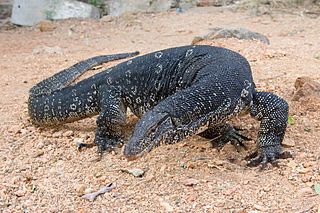 W
WThe Asian water monitor, also called common water monitor, is a large varanid lizard native to South and Southeast Asia. It is one of the most common monitor lizards in Asia, ranging from Sri Lanka and coastal northeast India to Indochina, Malay Peninsula, and Indonesian islands where it lives close to water. It is listed as Least Concern on the IUCN Red List. It was described by Laurenti in 1768 and is among the largest squamates in the world.
 W
WAspidelaps lubricus, commonly known as the Cape coral snake or the Cape coral cobra, is a species of venomous snake in the family Elapidae. The species is endemic to parts of southern Africa.
 W
WThe Balkan whip snake is a species of snake in the family Colubridae. It is found in Italy, Greece and most of the Balkan countries where its natural habitats are Mediterranean-type shrubby vegetation, pastureland, plantations and rural gardens. It is threatened by habitat loss in parts of its range but overall is assessed by the IUCN as being of "least concern".
 W
WCalliophis intestinalis, commonly known as the banded Malaysian coral snake, is a species of venomous elapid snake endemic to Southeast Asia.
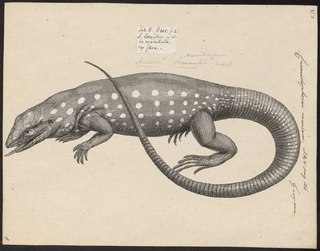 W
WCnemidophorus murinus, known commonly as Laurent's whiptail, is a species of lizard in the family Teiidae (whiptails). The species is endemic to Curacao, and is oviparous.
 W
WCrotaphopeltis hotamboeia, commonly known as the herald snake or the red-lipped snake, is a species of snake in the family Colubridae. The species is endemic to Sub-Saharan Africa.
 W
WThe red-tailed pipe snake, red cylinder snake, or common pipe snake, Cylindrophis ruffus is a snake species found in Southeast Asia. No subspecies are currently recognized.
 W
WThe dice snake is a Eurasian nonvenomous snake belonging to the family Colubridae, subfamily Natricinae. It is also called water snake.
 W
WDipsas indica, also known as the Neo-tropical snail-eater, is a snake species found in South America. It feeds on slugs and snails, which the snake can extract from their shells using its slender jaw.
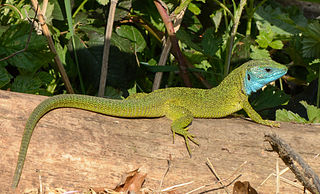 W
WThe European green lizard is a large lizard distributed across European midlatitudes from Slovenia and eastern Austria to as far east as the Black Sea coasts of Ukraine and Turkey. It is often seen sunning on rocks or lawns, or sheltering amongst bushes.
 W
WGonocephalus chamaeleontinus, the chameleon forest dragon or chameleon anglehead lizard, is a species of agamid lizard from Indonesia and Malaysia.
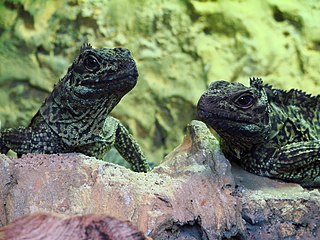 W
WThe Amboina sail-finned lizard or Amboina sailfin lizard is the largest agamid lizard in the world, growing to over one metre (3.3 ft) in length. It is found in wooded habitats near water in New Guinea and Ambon/Amboina Island (Indonesia). Although it has been reported from the Philippines and Sulawesi, a genetic study have shown that all in the former country are Philippine sailfin lizards H. pustulatus, while genetic and morphological studies have shown that individuals from the latter island belong to two separate to which the names H. celebensis and H. microlophus are available. Adult male Amboina sail-finned lizards have outer edges of the eyes that are medium-dark clear blue and no nose crest, which are some of the features that separate them from the Sulawesi species.
 W
WHypnale nepa, the Sri Lankan hump-nosed viper, is a venomous pitviper species endemic to Sri Lanka where it is known as මූකලන් තෙලිස්සා in Sinhala. Earlier thought that Hypnale walli and Hypnale nepa were two distinct species, but it is now accepted that it is the same species and Hypnale walli is a synonym name. Relatively small, they are distinguished by a strongly upturned snout. No subspecies are currently recognized.
 W
WThe Indian chameleon is a species of chameleon found in Sri Lanka, India, and other parts of South Asia. Like other chameleons, this species has a long tongue, feet that are shaped into bifid claspers, a prehensile tail, independent eye movement, and the ability to change skin colour. They move slowly with a bobbing or swaying movement and are usually arboreal. Strangely, they do not choose the background colour and may not even be able to perceive colour differences. They are usually in shades of green or brown or with bands. They can change colour rapidly and the primary purpose of colour change is for communication with other chameleons and for controlling body temperature by changing to dark colours to absorb heat.
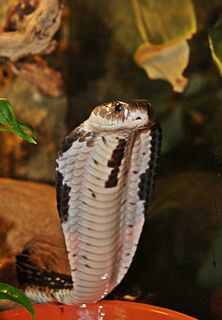 W
WThe Indochinese spitting cobra also called the Thai spitting cobra, Siamese spitting cobra or black-and-white spitting cobra, is a species of spitting cobra found in Southeast Asia.
 W
WThe Lesser Antillean iguana is a large arboreal lizard endemic to the Lesser Antilles. It is one of three species of lizard of the genus Iguana and is in severe decline due to habitat destruction, introduced feral predators, hunting, and hybridization with its introduced sister species, the green iguana. Successful captive breeding of this species has been limited to only two instances, as most captive-laid eggs tend to be infertile.
 W
WThe Nile crocodile is a large crocodilian native to freshwater habitats in Africa, where it is present in 26 countries. Due to its widespread occurrence and stable population trend, it has been listed as Least Concern on the IUCN Red List since 1996. It is widely distributed throughout sub-Saharan Africa, occurring mostly in the central, eastern, and southern regions of the continent, and lives in different types of aquatic environments such as lakes, rivers, swamps, and marshlands. Although capable of living in saline environments, this species is rarely found in saltwater, but occasionally inhabits deltas and brackish lakes. The range of this species once stretched northward throughout the Nile, as far north as the Nile delta. On average, the adult male Nile crocodile is between 3.5 and 5 m in length and weighs 225 to 750 kg . However, specimens exceeding 6.1 m (20 ft) in length and weighing up to 1,089 kg (2,400 lb) have been recorded. It is the largest freshwater predator in Africa, and may be considered the second-largest extant reptile in the world, after the saltwater crocodile. Sexual dimorphism is prevalent, and females are usually about 30% smaller than males. They have thick, scaly, heavily armoured skin.
 W
WPodarcis muralis is a species of lizard with a large distribution in Europe and well-established introduced populations in North America, where it is also called the European wall lizard. It can grow to about 20 cm (7.9 in) in total length.
 W
WSiphlophis cervinus (checkerbelly) is a rare snake found in Amazonian South America and Trinidad and Tobago.
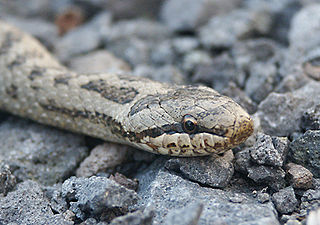 W
WThe smooth snake is a species of non-venomous snake in the family Colubridae. The species is found in northern and central Europe, but also as far east as northern Iran. The Reptile Database recognizes two subspecies as being valid, including the nominotypical subspecies described here.
 W
WVipera aspis francisciredi is a venomous viper subspecies endemic to northern and central Italy and adjacent Croatia, Slovenia, and Switzerland.